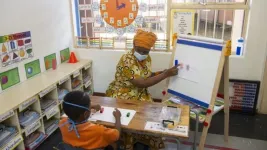Climate change could have direct consequences on malaria transmission in Africa
2021-03-10
(Press-News.org) The slowdown in global warming that was observed at the end of last century was reflected by a decrease in malaria transmission in the Ethiopian highlands, according to a study led by the Barcelona Institute for Global Health (ISGlobal), an institution supported by "la Caixa" Foundation, and the University of Chicago. The results, published in Nature Communications, underscore the close connection between climate and health.
For several years there has been a heated debate on the impact of global warming on malaria incidence. It is believed that the largest effect could occur in the highlands, where lower temperatures limit vector abundance, leading to intermittent and seasonal disease outbreaks. "We see that malaria epidemiology in these areas is strongly under climate control at all scales (months, years and even decades), which settles once and for all the debate on whether climate change is affecting or not the dynamics of malaria in Africa", says Xavier Rodó, Head of the Climate and Health Programme at ISGlobal and first author of the study.
At the turn of the century, a clear decrease in malaria incidence was observed in East Africa. This decline could be simply the result of disease control measures, or could reflect the temporary slowdown in increase in global mean surface temperature, a phenomenon that was observed between 1998 and 2005.
To answer this question, Rodó and colleagues focused on the region of Oromia in Ethiopia, a densely populated highland between 1,600 and 2,500 m above sea level. This region presents the advantage of having complete records of annual cases of malaria caused by both P. falciparum and P. vivax parasites between 1968 and 2007, and that public health interventions to control the disease were not reinforced in the region until 2004. This allows to separate the effect of climate from the effect of disease control measures for two parasites that are known to respond differently to climate.
Using mathematical modelling, the research team analysed the association between malaria cases, regional climate (local temperatures and rainfall) and global climate (in particular the effect of El Niño and the Pacific Decadal Oscillation on the Pacific Ocean). The results show that the variation in malaria cases correlates extremely well with changes in regional temperatures: the regional decline in temperatures linked to the slowdown in climate change coincided with the reduction in malaria cases observed from 2000, five years before disease control measures were reinforced. This decline in cases coincided with the slowdown in the increase of global surface temperature, as a result of the El Niño and the Pacific Decadal Oscillation. The analysis shows there is a "chain of effects" from global climate variability to regional temperature variations in East Africa, which translates into new malaria cases in the Ethiopian highlands.
"The coupling between disease dynamics and climate conditions is so strong that it is evident at multiple temporal scales, from seasonality to multiannual cycles to decadal trends. Malaria incidence not only tracked changes in temperature, which we had demonstrated before, but also in the decrease at the turn of the century, the focus of this work," says Mercedes Pascual, researcher at the University of Chicago and last author of the study.
For Rodó, "the evidence that the slowdown in warming influenced malaria transmission demonstrates the strong coupling between disease and climate". These results also emphasise the value of considering climate conditions when evaluating public health interventions aimed at disease control, and of integrating them into early warning systems.
INFORMATION:
Reference
Rodó X, Martinez PP, Siraj A and Pascual M. Malaria trends in Ethiopian highlands track the 2000 'slowdown' in global warming. Nature Communications. 10 March 2021. DOI: 10.1038/s41467-021-21815-y. https://www.nature.com/articles/s41467-021-21815-y.
ELSE PRESS RELEASES FROM THIS DATE:
2021-03-10
The human brain is less accessible than other organs because it is covered by a thick, hard skull. As a result, researches have been limited to low-resolution imaging or analysis of brain signals measured outside the skull. This has proved to be a major hindrance in brain research, including research on the different developmental stages, causes of diseases, and their treatments. Recently, studies have been performed using primary neurons from rats or human-derived *induced pluripotent stem cells (iPSCs) to create artificial brain models that have been applied to investigate brain developmental ...
2021-03-10
First grade teachers can find out who is on track with math and who is lagging, using an accurate diagnostic test that they can administer in the classroom.
After Covid-19 school reopening, or during catch-up sessions in the holidays, this is instrument can also be useful, especially in large, multilingual classrooms.
The test is supplemented by a 15-week 1-hour-a week "maths boost" invention program for first graders.
The program provides teachers good instructional material to support children in an efficient way.
Uniquely, the test measures numeracy skills along with listening comprehension and executive functions, pinpointing additional reasons why students improve ...
2021-03-10
Researchers from University of Texas-Arlington, University of Virginia, Sun Yat-Sen University, and University of Washington published a new paper in the Journal of Marketing that seeks to advance the discipline of avatar-based marketing.
The study, forthcoming in the Journal of Marketing, is titled "An Emerging Theory of Avatar Marketing" and is authored by Fred Miao, Irina Kozlenkova, Haizhong Wang, Tao Xie, and Robert Palmatier.
In 2020, Samsung's Star Labs brought digital avatars to CES 2020. However, this promotion was burned by its own fanfare. The avatars looked realistic ...
2021-03-10
Electronic textiles offer revolutionary new opportunities in various fields, in particular healthcare. But to be sustainable, they need to be made of renewable materials. A research team led by Chalmers University of Technology, Sweden, now presents a thread made of conductive cellulose, which offers fascinating and practical possibilities for electronic textiles.
"Miniature, wearable, electronic gadgets are ever more common in our daily lives. But currently, they are often dependent on rare, or in some cases toxic, materials. They are also leading to a gradual build-up of great mountains of electronic waste. There is a real need for organic, renewable materials for use in electronic textiles," says Sozan Darabi, doctoral student at the Department of Chemistry and Chemical Engineering ...
2021-03-10
The efficiency of solar cells can be increased by exploiting a phenomenon known as singlet fission. However, unexplained energy losses during the reaction have until now been a major problem. A research group led by scientists at Linköping University, Sweden, has discovered what happens during singlet fission and where the lost energy goes. The results have been published in the journal Cell Reports Physical Science.
Solar energy is one of the most important fossil-free and eco-friendly sustainable sources of electricity. The silicon-based solar cells currently in use can at most use approximately 33% of the energy in sunlight and convert it to electricity. This ...
2021-03-10
(LOS ANGELES) - Non-alcoholic fatty liver disease (NAFLD) is the most prevalent chronic liver disease worldwide. It is found in 30% of people in developed countries and occurs in approximately 25% of people in the United States. Risk factors for the disease include obesity, diabetes, high cholesterol and poor eating habits, although this does not exclude individuals without these risk factors.
There is normally a small amount of fat found in the liver; however, if the amount of fat makes up 5% or more of the liver, this is considered to be NAFLD and it must be managed ...
2021-03-10
WEST LAFAYETTE, Ind. - New contact lens technology to help diagnose and monitor medical conditions may soon be ready for clinical trials.
A team of researchers from Purdue University worked with biomedical, mechanical and chemical engineers, along with clinicians, to develop the novel technology. The team enabled commercial soft contact lenses to be a bioinstrumentation tool for unobtrusive monitoring of clinically important information associated with underlying ocular health conditions.
The team's work is published in Nature Communications. The Purdue Research Foundation Office of Technology Commercialization helped secure a patent for the technology and it is available ...
2021-03-10
Armando Collazo Garcia III got more than he expected from a graduate course he took last spring. He developed a new understanding of the physics of transonic shocks produced across a laminar flow airfoil with boundary-layer suction and added a published paper to his resume.
"When I got the assignment to do a research project, I realized I already had a good data set from my master's thesis that I could use in a new way," Collazo Garcia said. "I was able to apply linear algebra techniques to manipulate the flow field data and decompose the information into modes. The modes provided a snapshot of various aspects of the flow and were ranked by their energy contribution, ...
2021-03-10
Scientists have used modern genetic techniques to prove age-old assumptions about what sizes of fish to leave in the sea to preserve the future of local fisheries.
"We've known for decades that bigger fish produce exponentially more eggs," said the lead author of the new study, Charles Lavin, who is a research fellow from James Cook University (JCU) and Nord University in Norway.
"However, we also found while these big fish contributed significantly to keeping the population going--they are also rare."
Co-author Dr Hugo Harrison from the ARC Centre of Excellence for Coral Reef Studies ...
2021-03-10
New international research published in Anaesthesia (a journal of the Association of Anaesthetists) concludes that surgery should be delayed for seven weeks after a patient tests positive for SARS-CoV-2, since the data show that surgery that takes place between 0 and 6 weeks after diagnosis is associated with increased mortality.
The study is by the COVIDSurg Collaborative: a global collaboration of over 15,000 surgeons working together to collect a range of data on the COVID-19 pandemic. This study's lead authors are Dr Dmitri Nepogodiev (Public Health) and Dr Aneel Bhangu (Surgeon) of the University of Birmingham, UK.
While it is known that infection with SARS-CoV-2 during surgery increases mortality and international guidelines recommend ...
LAST 30 PRESS RELEASES:
[Press-News.org] Climate change could have direct consequences on malaria transmission in Africa







